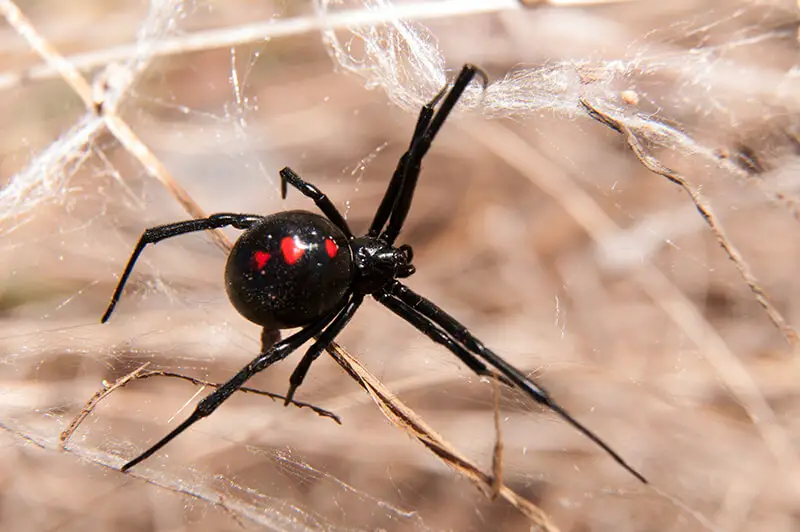Black widows are some of the most iconic yet misunderstood spiders living in California. Their shiny black bodies, red hourglass markings, and famously potent venom have fueled decades of fear, folklore, and exaggeration. Yet beneath the dramatic reputation lies a biologically fascinating species that plays a crucial ecological role throughout the state. From coastal suburbs and Central Valley agriculture to the Mojave and Colorado deserts, black widows thrive in habitats shaped by California’s wide-ranging climates.
California is home primarily to the western black widow (Latrodectus hesperus), a species uniquely adapted to the state’s warm summers, mild winters, and increasingly urbanized environments. While their venom is medically significant, their behavior, reproductive biology, predator–prey interactions, and ecological functions are far more nuanced than most people realize.
Below are nine essential facts about black widows in California—facts that genuinely matter for understanding, avoiding, and coexisting with this secretive spider.
1. Western Black Widows Are Native to Almost Every Region of California

They Thrive in Warm, Dry, and Human-Modified Environments
The western black widow naturally inhabits chaparral, desert scrub, oak woodlands, and grasslands. However, California’s urban and suburban structures—garages, sheds, crawl spaces, irrigation boxes, and patio furniture—mimic their ideal hiding spots.
Human environments create sheltered, warm microhabitats.
Their adaptability explains their statewide presence.
They Avoid Open Exposure and Prefer Hidden Crevices
Black widows rarely wander in the open. They prefer dark corners, cracks, vents, piles of wood, and clutter where they can build irregular webs without disturbance.
These sites offer protection from predators and climate extremes.
California structures unintentionally supply abundant niches.
Their Range Stretches From Coastal Regions to Desert Valleys
Western black widows are especially common in Southern California, the Central Valley, and the interior foothills. They are less common at high elevations but can survive in lower Sierra Nevada communities.
Their breadth of distribution mirrors California’s climate diversity.
Few spider species are as widespread.
2. Black Widow Venom Is Potent—but Bites Are Rare and Often Avoidable
Their Venom Contains Neurotoxins, Not Tissue-Destroying Enzymes
Black widow venom contains alpha-latrotoxin, which disrupts nerve signaling. Symptoms include muscle cramping, sweating, and localized pain—not the necrosis seen in brown recluse bites.
Most bites are medically treatable.
Pain can be intense but rarely life-threatening.
They Bite Only When They Cannot Escape
Black widows are shy, solitary, and defensive—not aggressive. Most bites occur when a spider is pressed against skin (for example, inside gloves or shoes).
Accidental compression is the most common cause.
Intentional biting is extremely rare.
Severe Symptoms Are Uncommon
Healthy adults typically experience mild to moderate symptoms. Children, the elderly, and those with underlying conditions may require medical attention.
California emergency departments rarely see severe cases.
Modern antivenom exists but is seldom necessary.
3. Female Widows Are Larger and More Venomous Than Males
Females Are the Ones Most People Recognize
Female black widows have the distinctive glossy black coloration and red hourglass marking. They are larger, more visible, and more likely to stay near their webs.
Females are responsible for almost all reported bites.
Their defensive behavior reflects maternal instincts and territoriality.
Males Are Much Smaller and Harmless to Humans
Male black widows are brown or tan, with small black spots instead of bright markings. They cannot inject clinically significant venom.
Male–female interactions drive much of black widow mythology.
Males rarely encounter humans because they spend life searching for mates.
Sexual Cannibalism Is Exaggerated
While females sometimes consume males after mating, this behavior is far less common in the wild than popular culture suggests. Males often escape unharmed.
Cannibalism depends on hunger, stress, and environmental conditions.
Hollywood dramatization has shaped public perception.
4. California’s Climate Influences Black Widow Reproduction Strongly
Warm Summers Boost Spiderling Survival
Black widows lay eggs from late spring to early fall. Warm California temperatures accelerate egg development and spiderling hatching.
High heat shortens generational cycles.
Warm microclimates increase survival rates statewide.
Females Produce Multiple Egg Sacs per Season
A single female may produce 4–9 egg sacs, each containing 100–400 eggs. Most spiderlings do not survive due to cannibalism, predators, and climate stress.
High reproductive output compensates for low juvenile survival.
Female reproductive success shapes population growth patterns.
Rainfall Affects Early Life Stages
Heavy rains can destroy webs, wash away spiderlings, or reduce prey availability. Drought years often favor black widows by reducing competitors and boosting insect populations.
California’s climate oscillations influence widow abundance.
Their reproductive cycle adapts to changing conditions.
5. Black Widows Are Skilled Nocturnal Hunters With Unique Web Designs
Widow Webs Are Irregular, Not Classical Orb Webs
Black widows build tangled, three-dimensional webs with sticky trip lines near the base. The irregular shape helps trap crawling insects.
These webs function like ground-level snares.
Their architecture reflects their predatory strategy.
They Hunt Primarily at Night
At night, females hang upside down in the web to sense vibrations and capture prey. They consume beetles, ants, crickets, moths, and occasional small vertebrates.
Their nocturnal schedule reduces predation risk.
Nighttime activity makes sightings rare.
Their Bite Is Designed for Subduing Insects, Not Fighting Large Animals
Venom rapidly immobilizes prey, enabling digestion. Against humans or large animals, their venom has limited functional purpose.
Their hunting biology explains their generally non-aggressive nature.
Widows are predators of invertebrates—not attackers of humans.
6. Black Widows Play an Important Ecological Role in California
They Help Control Insect Pests
By consuming agricultural pests, cockroaches, grasshoppers, and other insects, black widows indirectly support California’s agricultural systems.
Their predatory role benefits homes, gardens, and orchards.
They reduce insect populations naturally.
They Are Prey for Larger Animals
Even venomous spiders have predators: birds, lizards, centipedes, mantises, and other spiders regularly prey on black widows.
Predation maintains widow population balance.
They fit into a larger ecological web.
They Contribute to Nutrient Cycling
Widow webs trap insects that might otherwise die and decompose elsewhere. This micro-predation helps distribute nutrients across small habitats.
Their ecological value is underappreciated.
They are integral components of microecosystems.
7. Black Widow Behavior Changes Dramatically Between Urban and Wild Areas
Urban Widows Build Webs Closer to the Ground
In garages and patios, widows stay near cool, stable, shaded surfaces. These places lack natural predators, making them safer nesting areas.
Urban structures increase reproductive success.
Their presence reflects human–wildlife overlap.
Wild Widows Face Greater Predation Pressure
In natural habitats, widow webs are strategically placed in shrubs, under rocks, and inside burrows. These locations hide them from lizards and rodents that hunt spiders.
Wild widows behave more cautiously.
Predator presence shapes web architecture.
Food Availability Differs Greatly
Urban environments often provide consistent insect prey due to lights and human activity. Natural habitats have seasonal fluctuations in prey.
Widows adjust web size and location according to prey abundance.
Flexibility supports survival in highly variable environments.
8. Black Widows Are Often Misidentified—Especially in California Suburbs
Many Harmless Spiders Are Mistaken for Widows
False widows, house spiders, orb weavers, and juvenile widows confuse many residents. Size, color variation, and immature patterns make identification tricky.
Not all dark spiders are black widows.
Misidentification increases unnecessary fear.
Juvenile Widows Look Nothing Like Adults
Young western black widows are tan or brown with spotted patterns. Their red markings develop with age.
These differences cause confusion in California’s garages and sheds.
Accurate ID helps avoid unnecessary extermination.
Male Widows Are Almost Never Recognized
Because males are tiny, brown, and harmless, people rarely realize they are seeing a black widow species.
Most males go unnoticed entirely.
Understanding gender differences reduces public anxiety.
9. Black Widow Encounters in California Are Common—but Dangerous Interactions Are Not
Most Encounters Happen Around Human Structures
Gardening, reaching into storage areas, moving wood piles, and cleaning garages are the most common scenarios leading to bites.
These activities disturb hidden spiders.
Awareness reduces risk significantly.
California Agriculture Workers See Widows Regularly
Farm workers, landscapers, and vineyard staff encounter black widows frequently. Gloves, long sleeves, and tool shaking reduce bite risk.
Safety habits prevent nearly all incidents.
Widows are predictable in where they hide.
Households Can Reduce Encounters Through Simple Maintenance
Removing clutter, sealing cracks, shifting firewood away from walls, and reducing outdoor lights (to reduce insect prey) all reduce widow populations.
Home maintenance is more effective than insecticides.
Prevention is straightforward once habits are understood.
FAQs About Black Widows in California
Are black widow bites deadly?
Deaths are extremely rare. Bites can be painful but are treatable.
Where are black widows most common in California?
Southern California, the Central Valley, coastal suburbs, and desert edges.
What do black widows eat?
Insects, arachnids, and occasionally small vertebrates.
Are all black widows venomous?
Only females deliver medically significant bites.
Are black widows aggressive?
No. They prefer retreat and bite only when pressed.
How can I avoid black widow bites?
Wear gloves, reduce clutter, and check dark corners before reaching in.
Do black widows live indoors?
They prefer sheltered outdoor structures, though they may enter garages or sheds.
Are black widows beneficial?
Yes. They control insect pests naturally.
Conclusion
Black widows in California are far more complex and ecologically important than their ominous reputation suggests. Their unique venom chemistry, nocturnal hunting strategies, reproductive behaviors, statewide adaptability, and preference for dark, stable microhabitats reveal a species finely tuned to California’s varied landscapes. These nine essential facts highlight how misunderstandings fuel fear—when in reality, black widows are shy, cautious predators that avoid confrontation whenever possible.
Understanding their biology not only reduces unnecessary worry but also encourages coexistence with one of California’s most iconic and scientifically remarkable arachnids.






